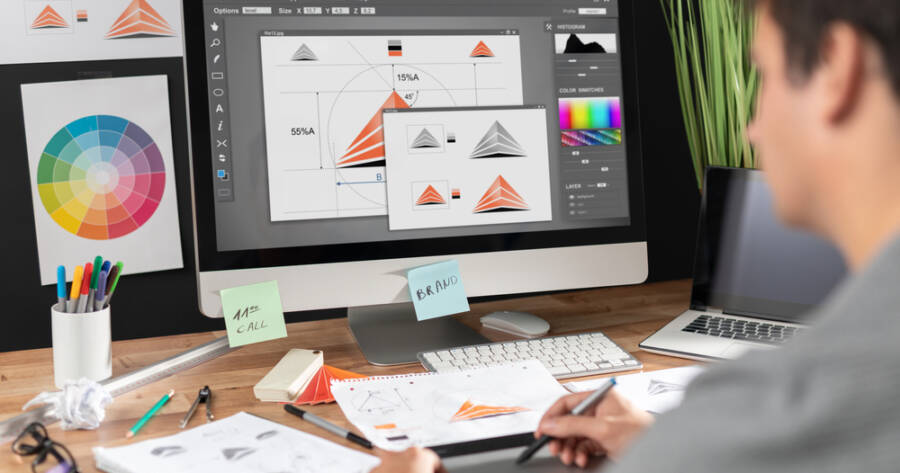Embarking on a journey into the world of graphic design can be both exciting and daunting. With so much to learn and explore, it’s important to have a solid starting point. This article aims to guide beginners through the initial steps, offering practical advice and insights that can potentially smooth the path into this creative field. Whether you’re exploring this as a hobby or considering a career switch, the fundamentals of graphic design might offer you a new lens through which to express creativity.
Understanding the Basics of Graphic Design
Before diving into tools and software, it’s essential to understand what graphic design entails. Graphic design integrates art and technology to communicate ideas visually, often combining text and images to create visually appealing content. Designers use elements like color, typography, and layout to create their designs.
Having a foundational understanding of these components can arguably help beginners start with confidence. Basic principles like balance, contrast, and alignment frequently play a vital role in successful design work. Familiarizing yourself with these principles could enhance your ability to create designs that are not only aesthetically pleasing but also functional.
Choosing the Right Tools and Software
In the realm of graphic design, selecting the right tools is crucial. While there are many options available, beginners might benefit from starting with user-friendly software. Many budding designers find tools like Adobe Illustrator, Photoshop, or InDesign to be industry standards. However, exploring free alternatives such as GIMP or Canva could be advantageous for beginners who wish to avoid initial costs.
Each software has its unique set of features, and your choice may largely depend on the type of design projects you are interested in. For instance, Illustrator is often preferred for vector-based designs, while Photoshop is favored for photo editing. Taking the time to explore these tools and even experimenting with trial versions might help you develop a preference tailored to your style and needs.
Building a Strong Foundation Through Learning
Education is key when it comes to mastering graphic design. While formal education in design can be beneficial, many successful designers are self-taught. Online resources, including tutorials, webinars, and courses, can provide substantial insights into the craft. Platforms like Coursera, Skillshare, and YouTube offer a wealth of knowledge that can be accessed at your convenience.
Practicing what you learn is often considered essential in developing your skills. Engaging in personal projects or participating in design challenges can offer practical experience that could enhance your learning process. Constant experimentation and seeking feedback may pave the way for improvement and increased understanding of design concepts.
Developing Your Unique Style
Every designer eventually develops their unique style, which can be considered a crucial aspect of professional growth. Experimenting with different techniques, color schemes, and layouts might help in discovering what sets your work apart. Looking at a variety of design styles can also inspire new ideas and approaches.
While it’s wise to draw inspiration from established designers, it is equally important to step outside of current trends occasionally and chart your own creative path. This individuality could potentially distinguish your work and make it memorable to others.
Building a Portfolio and Networking
Having a solid portfolio is often pivotal for budding designers. It serves as a showcase of your work and skills to potential clients or employers. Start by assembling a collection of your best projects, ensuring variety to display your capabilities across different styles and formats.
Networking in the design community might also prove beneficial. Consider joining groups, attending workshops, and participating in forums to connect with other designers. Such interactions can provide opportunities for collaboration, feedback, and potential job leads. Remember, a supportive community can frequently be an invaluable resource in your design journey.
Embracing Challenges and Staying Current
Graphic design is a field that continuously evolves with technological advancements and cultural shifts. Staying updated with the latest trends and tools could considerably enhance your marketable skills. Consider subscribing to design blogs, podcasts, and attending industry conferences to remain informed.
Challenges in this journey are inevitable, but they often present valuable learning opportunities. Embracing them with a problem-solving mindset might significantly contribute to your growth and innovation as a designer. Flexibility and adaptability are key traits that can empower you to thrive in this dynamic field.
Your Creative Journey Awaits
Beginning a career or hobby in graphic design may seem overwhelming at first, but with the right approach, it can become a fulfilling journey. By grasping basic concepts, choosing appropriate tools, committing to continuous learning, and fostering a unique style, you could lay a strong foundation for your design ambitions.
Remember, perseverance and passion often lead to success in creative endeavors. As you embark on this path, embrace each challenge as an opportunity for growth, and let your creativity be the guiding force in your exploration of visual storytelling.





